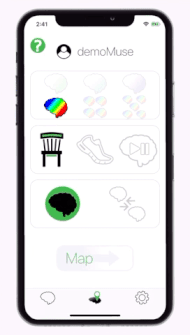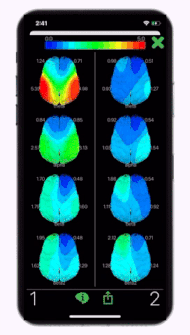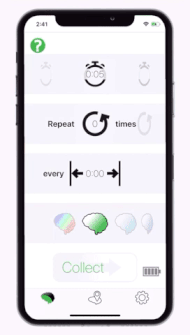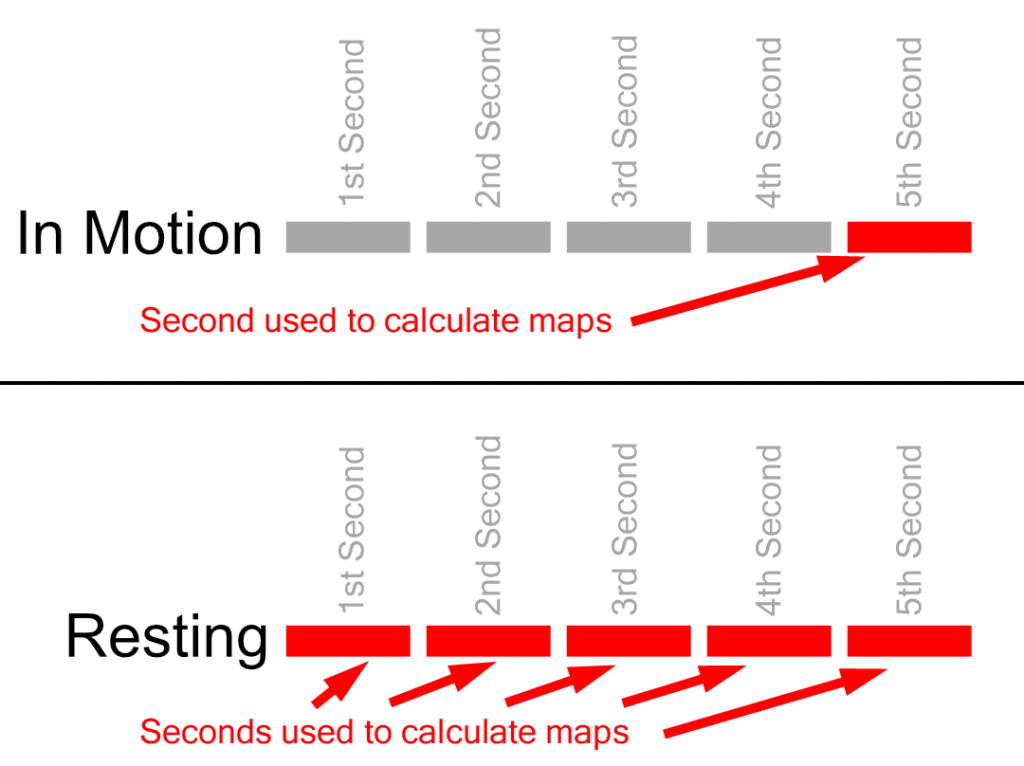Most brain activity research and software focuses on collecting brain data while sitting still and either meditating or performing logic puzzles. However, Opti Brain differs from this because we specialize in collecting brain data while your body is in motion!
You may be interested in collecting brain data while doing many different activities. We will help you understand how to analyze your brain maps depending on what you are doing. To make things simple we will categorize every type of brain data collection into “resting” or “in motion”. After finishing a collection, go to the mapping tab to setup your map. If you collected while “resting” then make sure you select the chair icon. If you collected while “in motion” select the shoe icon.
Resting Collections

Resting collections take place while sitting or standing still and quiet. A popular measure to record is your resting brain state. This can be done by recording 30 seconds of data while sitting still and looking straight ahead with your eyes open. A resting collection can give you a general idea of your current brain state. It would be beneficial to take resting collections before and after any large events or mood changes such as a rigorous work out or a job interview.
Use the compare collections setting to see how a large mood change affects your brain activity. Comparing a resting collection from before and after your mood changing event.


In Motion Collections

The second type of brain collection is ‘in motion’. At Opti Brain we specialize in collecting data while in action or more specifically just before your movement starts. Debbie Crews, PhD (Opti Brain CEO) found in her 35+ years of research, that your brain state between 1 and 2 seconds before start a significant activity is the most correlated to performance. For example, if you are putting a golf ball, your success is not determined by “what” you think or the physical routine. However, “how” you think 1 second before you pull your club back to roll the ball does affect your performance. This final second is artifact free and predictive of success.

Here is an example of how you would collect data during an in motion collection. First decide what time frame for your collection is most appropriate. This will depend of the activity you are performing. For example, if you are putting a golf ball, you may select 5 or 10 seconds to capture your putting routine. Or you may select 3s to capture just the motion of your putt. Sometimes, it is helpful for someone else to help you capture your brain collection. They can simply press ‘Stop’ after you have started your motion. Time the collection so that it stops immediately before you start the motion.
Creating Brain Maps
Resting maps are calculated completely different from in motion maps. So it is important to select the correct button (the chair or the shoe) when setting up your map. Before seeing the difference between the two calculations it is helpful to understand what an epoch is.
Epoch
An epoch is one short time burst of brain data. When brain waves are analyzed they are divided into epochs to make analysis simpler. In Opti Brain apps, all epochs are 1 second in length. The 1st second of data from the collection is the 1st epoch. The 2nd second of data is the next epoch, all the way until the collection ends.
Each one second epoch of brain data is individually analyzed by calculating the power at each electrode site in the headset. For example, the Muse headset contains four electrode sites. Two in the front near your temples and two on the back behind your ears. The power is calculated for 1 epoch at each of the four sites.
The different colors on a brain map (the multi-colored options) are the power in that area of the brain. When the color is dark blue the power is very low. When the color is red the power is high. However, recognize that anything over 5uV will be red and power may increase to 20+ uV. If your map has more than 30uV, the data likely contains artifact and you may want to repeat the collection.
Only four powers are calculated with the muse because the muse contains four electrode sites. Each pixel of color on the map is estimated from the power and position of the known electrode locations.
Resting vs. in motion
Resting collections average together the power from every single 1 second epoch of data. The result is a 1 second epoch of data representing the average activation during a collection. In contrast, in motion collections only map 1 single epoch from the collection (the epoch closest to the end of the collection). The below shows which epochs are used in the calculation of each type of collection.

In a resting collection, the epochs are averaged. This gives you an accurate estimation of the general mood or brain state your brain is currently in. This calculation will smooth over any anomalous brain thoughts or activity that does not represent your current mood.
In an in motion collection, only the second significant to predicting the outcome of your performance is mapped. You should note the importance of timing the end of a collection as close as possible to the second you have interest in mapping.
Artifact
There are times when facial tension or poor connectivity can create artifact in brain data collections. This means the brain activity collected is contaminated with muscle activity or poor electrode connections and is not accurate. If there is artifact detected anywhere in an epoch it is discarded when calculating maps.
For resting collections, this means that only epochs containing no artifact are averaged together to make the map. Any epochs containing artifact are completely discarded and all the left over epochs are averaged to create the brain maps.
For in motion collections, the last second containing no artifact is mapped. If the very last second contains artifact, the second before is checked. Each second before is checked until a second is found containing no artifact and that second is mapped. This is helpful in discerning the most important second. Since poor connection and facial tension are very common when you are moving, it is likely the program will find the last calm second just before you start your movement.
Sometimes every single second in the collection contains artifact. In result, a message will appear informing you all epochs contain artifact. The message will ask if you would like to map a different collection or keep all epochs with artifact in the calculations and still create the map.


